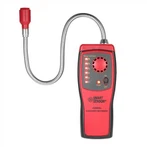Thermal anemometer principles and applications
1, is a thin wire placed in the fluid, through the current heating wire, so that its temperature is higher than the temperature of the fluid, so the wire anemometer is called. When the fluid flows through the wire in the vertical direction, a part of the heat of the wire will be taken away, so that the temperature of the wire decreases.
2, according to the theory of forced convection heat exchange, can be derived from the heat dissipated Q and the velocity of the fluid v between the existence of a relationship. The standard probe consists of two brackets tensioning a short, thin wire. The wire is usually made of platinum, rhodium, tungsten and other metals with high melting points and good ductility.
3, according to different uses, the head is also made into double wire, triple wire, oblique wire and V-shaped, X-shaped and so on. In order to increase the strength, sometimes with a metal film instead of wire, usually in a thermally insulated substrate sprayed with a thin metal film, called thermal film probe. The probe must be calibrated before use.
4, static calibration is carried out in a special standard wind tunnel, measuring the relationship between the flow rate and the output voltage and drawn as a standard curve; dynamic calibration is carried out in the known pulsating flow field, or in the anemometer heating circuit with a pulsating electrical signal, calibration line anemometer frequency response, if the frequency response is poor available to improve the corresponding compensation line.
The use of thermal anemometer:
1, the anemometer has a wide range of applications in all areas can be used flexibly, widely used in electric power, steel, petrochemical, energy saving and other industries, there are other applications in the Beijing Olympic Games, sailing competitions, rowing competitions, field shooting competitions, etc. anemometers need to be used in anemometers to measure.
2, there are many industries need to use anemometers, recommended industries: fishing industry, all kinds of fan manufacturing industry, the need for ventilation exhaust system industry and so on.
3, anemometer anemometer thermal probe works based on the principle of cold shock airflow to take away the heat element on the heat, with the help of a regulator switch to keep the temperature constant, then regulate the current and the flow rate is proportional to the relationship.
4, when using the thermal probe in turbulent flow, the airflow from all directions impacts the thermal element at the same time, which will affect the accuracy of the measurement results. Measured in turbulence, the thermal anemometer flow rate sensor is often higher than the rotating wheel type probe.
The above phenomenon can be observed during duct measurements. Depending on the different designs used to manage duct turbulence, they can occur even at low speeds. Therefore, the anemometer measurement process should be carried out in a straight part of the duct.






